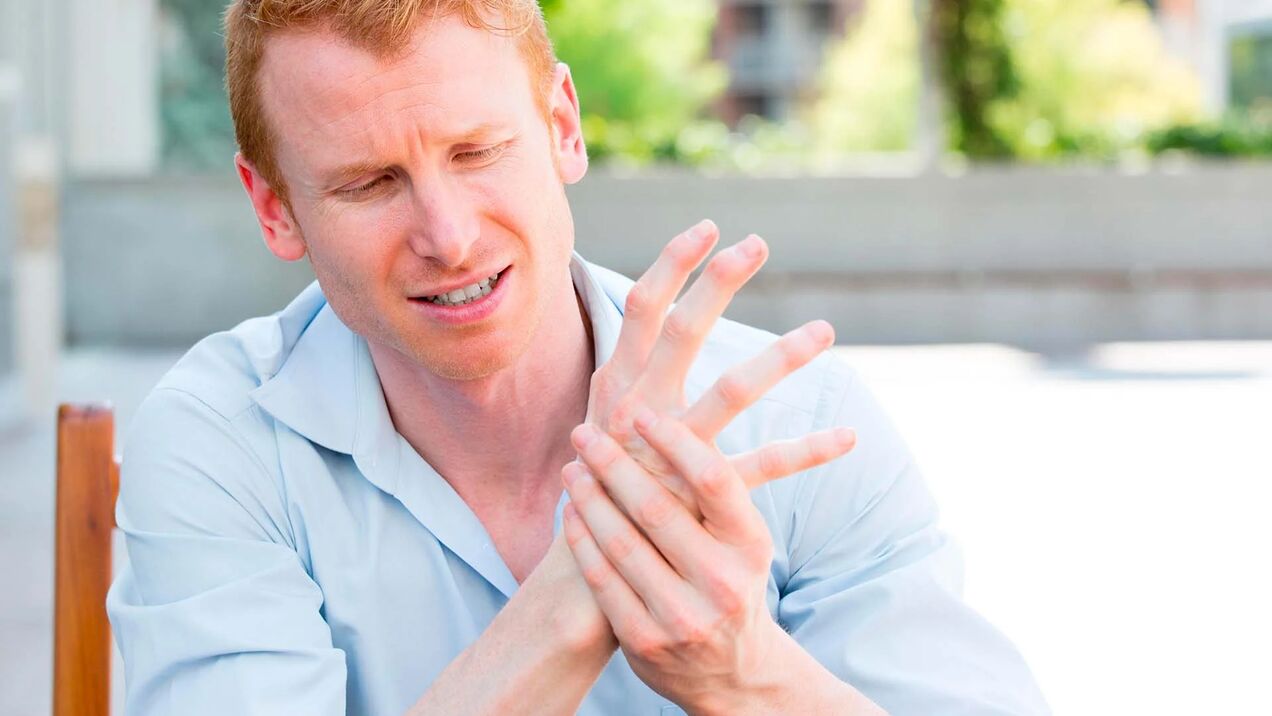
Small joint pain in fingers: causes
"Fingers snapping, " also known as stenosing deligamentitis or Knowles' disease
- Excessive fatigue of the wrist flexors. When working at a computer for long periods of time, driving long distances, carrying heavy bags, playing guitar, sustaining repeated blunt force injuries to the hands, or using tools that require a tight grip in the hand (such as construction).
- Metabolic disorders in the body: diabetes, decreased thyroid function - hypothyroidism.
- Smoking – Nicotine can damage small blood vessels and nerves.
- Have had an injury to the palm of your hand or the base of your finger.
hand injury
- The reason for the appearance. "Hammerfinger" is the result of an injury, for example, from a strong blow to the tip of an outstretched finger, such as being hit by a ball while playing basketball.
- Localization of buckling. The mallet finger flexes at the distal interphalangeal joint, which is the small joint of the finger closest to the nail. "Finger snapping" occurs when the proximal interphalangeal joint, the second joint of the finger from the nail, or the metacarpophalangeal joint connects the fingers to the palm itself.
- The mallet finger is often swollen, blue, and deformed, especially if the phalange bone is fractured.
Osteoarthritis
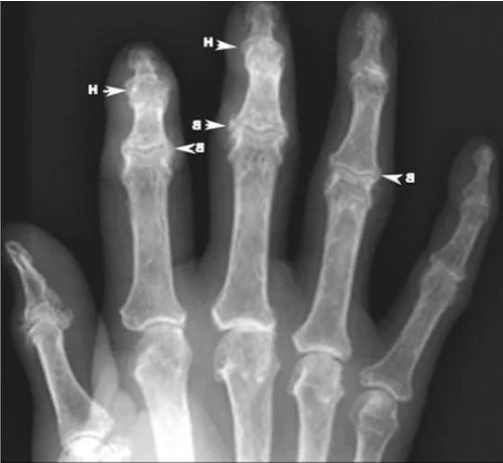
Rheumatoid arthritis and psoriatic arthritis
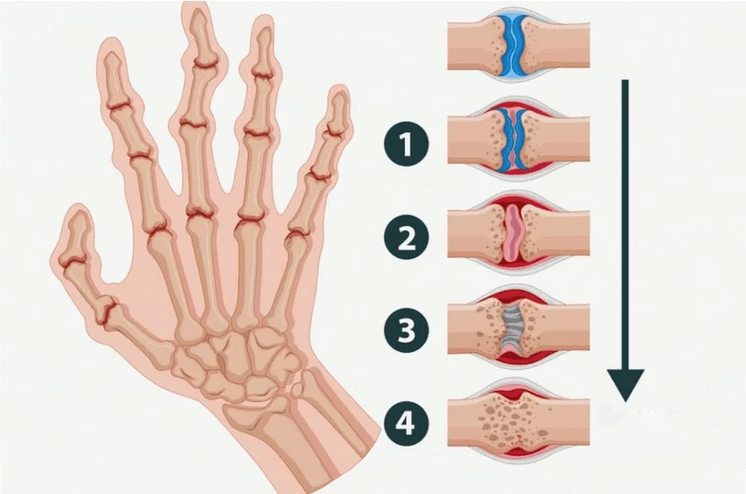
Gout and pseudogout
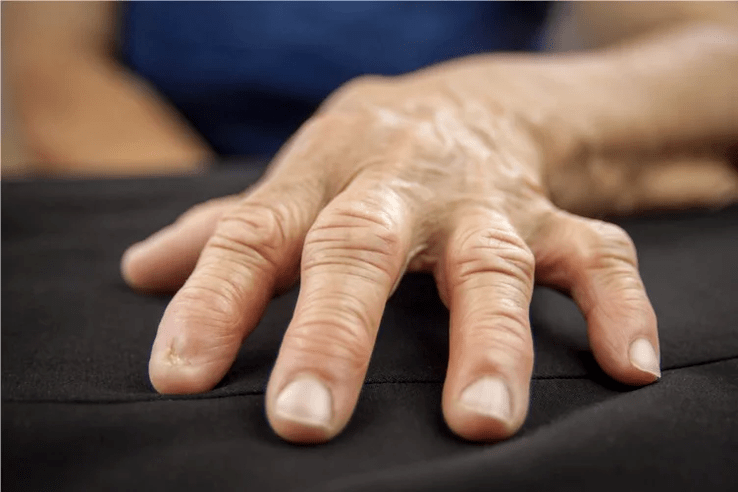
tumors and cysts
Infectious diseases of fingers
- Cellulite - inflammation of the subcutaneous tissue,
- Lymphangitis - inflammation of the lymphatic vessels,
- abscess - a collection of pus,
- Osteomyelitis - inflammation of the bones.
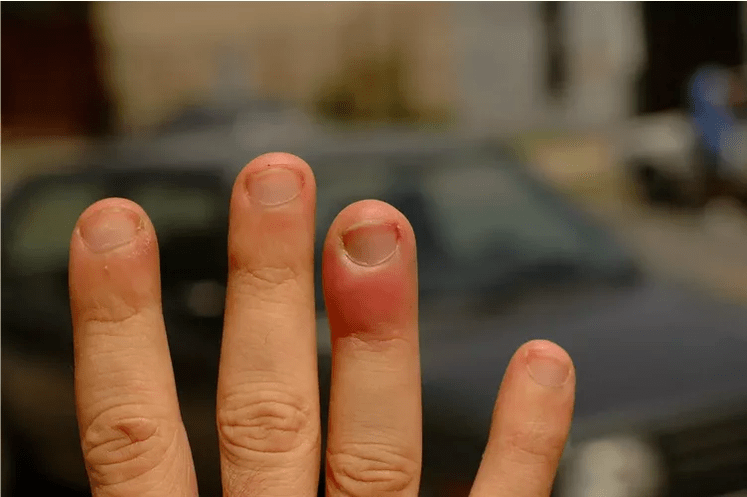
carpal tunnel syndrome
Palmar aponeurosis contracture or palmar fibromatosis
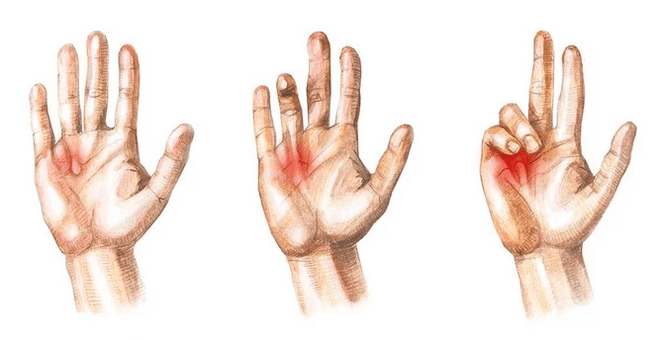
symptom
- The onset of pain may be acute or gradual.Diseases caused by degenerative changes and excessive fatigue of the ligamentous apparatus are characterized by a gradual onset, since the development of these processes takes time. Autoimmune diseases can manifest gradually or acutely. Gout and pseudogout worsen suddenly, reaching a peak of symptoms within a few hours. Trauma is also associated with severe pain.
- Times and factors that cause pain to appear or worsen during the day.With carpal tunnel syndrome, your hands may hurt at night; with osteoarthritis, the pain is worse when you put pressure on the joint; with rheumatoid arthritis, the pain may occur in the first 30 days after getting out of bed or after long periods of inactivity. The pain is most noticeable within minutes.
- Characteristics of joint flexion and extension: "Flickers" lock the joint in a flexed state but can be carefully moved to an extended position, while "hammer fingers" and contractures prevent full extension. When you have rheumatoid arthritis, you can see thickening and deformation of your finger joints. If there are pathological changes in the ligament, nodules can be felt in its components.
- Joint stiffness and limited movement.
- With gout and autoimmune arthritis, patients may notice that their joints are red and swollen and feel warm to the touch—all symptoms of inflammation.
- If the nerves are damaged, numbness, goosebumps, tingling, and decreased sensitivity to heat, cold, and touch may occur.
- With vasculitis (inflammation of blood vessels), fingers often turn white or blue.
- With many diseases, weakness in the hands may be observed: this indicates damage to the nerves, which can also occur when there is an injury.
- General symptoms, such as weakness, fever, and unexplained problems with other organs, indicate that the disease is systemic. In these cases, it is best to consult a doctor immediately.
diagnosis
- Hand X-ray in various projections- The most commonly used and most readily available method for assessing the condition of bones and joints. Testing is needed if fractures, foreign bodies, developmental abnormalities, tumors or cysts are suspected, as well as rheumatoid arthritis and osteoarthritis. X-rays show osteoarthritis as a narrowing of the joint space and the presence of bone growth (osteophytes).
- CT scan(CT). Used to better visualize complex fractures and assess joint condition.
- Ultrasound examination of soft tissues and joints of the hand. Allows you to visually see the condition of ligaments, tendons, nerve trunks and joints.
- MRI. This method provides clear layer-by-layer images of all hand structures. The main indications for use are ligament and tendon injuries.
- Neuroelectromyography. This method is necessary to evaluate the conduction of nerve impulses. It is used if carpal tunnel syndrome is suspected.
- blood test.The most common are:
- Metabolic markers - such as glycated hemoglobin and blood sugar in diabetes, as metabolic diseases can affect the condition of nerves, small blood vessels and ligaments.
- Tests to diagnose autoimmune diseases: erythrocyte sedimentation rate, C-reactive protein, rheumatoid factor, cyclic citrullinated peptide antibodies.
Which doctor should I contact?
How to relieve finger joint pain
- Surgical treatmentNecessary for hand suppuration as well as complex injuries. Open wounds also require surgical treatment. Any wound is a source of infection, and such patients require antibiotic treatment and debridement. Closed fractures can be treated conservatively. The fracture site is first rigidly fixed: 7-10 days for non-displaced fractures and 3 weeks for displaced fractures. Thereafter, the patient wears special orthotics on the hand until the bone has fully recovered - usually 4-10 weeks, sometimes longer.
Conservative treatmentIt is special for autoimmune diseases that affect the joints of the hands - it is based on drugs that suppress the immune response and is prescribed by rheumatologists. For musculoskeletal problems, systemic drug therapy is part of complex treatment. For hand joint pain, NSAIDs may be needed to relieve pain and inflammation. Local influence methods work well: - injectionCorticosteroids move into the joints of the hand and into the tendons. They are effective in relieving inflammation, but can have side effects and must be used strictly according to the indications.
- Soft fixation of handUse orthotics or elastic bandages. The location of fixation depends on the diagnosis.
- practiseHand muscles, experts will help you choose according to the pathological condition.
- acupuncture.The method involves inserting a sterile needle into biologically active points, which reduces pain and improves joint mobility.
- Shock wave therapy.In recent years, it has become increasingly popular in the treatment of ligament problems. Effectively and safely treat "finger snapping" and deformity osteoarthritis, reduce the possibility of recurrence, and improve joint mobility and overall hand function.
- Intramuscular Theo Taping.This requires special tape to be placed on the hand, which helps stabilize the joint in a comfortable position. This way he recovers faster.
- Laser Treatment.Reduces pain and aids in cartilage repair, which is extremely important in osteoarthritis.
- Magnet therapy.Designed to reduce pain, inflammation and swelling.
result
prevention
- Address common risk factors.Metabolic disorders, smoking, and hormonal disorders increase the risk of musculoskeletal problems in the hands. Maintaining normal blood sugar is important, especially if you have been diagnosed with diabetes. Gout patients are advised to follow a special diet, and some patients are prescribed anti-gout medications. It can be helpful to check the status of your thyroid gland regularly. Decreased function can negatively impact the immune system and the body as a whole.
- If your risk for joint disease is increased, take care of your hands.For example, if your job requires excessive strain on your hands, try to get into the most comfortable position, don't bend your hands a lot, and give them a rest and a little warm-up. Wear special gloves for exercise and monitor the condition of your skin and nails to prevent infection from penetrating the hand tissues. Get regular preventive check-ups with your doctor.


















